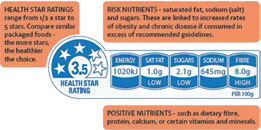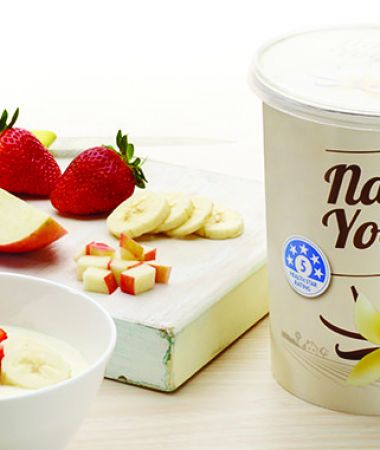By Ayse Halil
WE LIVE IN A TIME WHERE THE CONSUMER IS BECOMING MORE AWARE AND SELECTIVE OF FOODS THAT ARE AVAILABLE
HEALTH STAR RATING SYSTEM
The system was implemented in 2014, and is a voluntary label that food manufacturers and retailers can display on a packaged food product.
The aim of the system is to allow a simple representation of the food product based on its nutrient content. For the consumer, it allows you to see at a glance the health benefits of a particular food item and compare products within a category.
Being based on a star system, it is easy to tell if a food is ‘healthy’ depending on the number of stars it has. There is an additional panel that is presented with the stars, detailing the gram amount of certain nutrients.
As it is a visual rating, it provides an easier representation of the food item, rather than reading a nutrient panel, which some may find hard to understand. By also providing content of fat, sodium, sugar and other components of the food, you can theoretically make a healthy choice just by glancing the rating panel.

The Stars are based on the nutrient profile of a food, and takes into account:
• Energy (based in kilojoules)
• Risk nutrients: Saturated fat, sodium and sugar
• Positive nutrients: Protein, fibre, and the proportion of fruit, vegetable, nut and legume content in the food
The Star Rating is determined using a calculator that assesses the nutrient content of the food item, and was developed with Food Standards Australia New Zealand (FSANZ).
• Food additives and allergens – Certain allergens must always be declared on labels. Additives must also be listed in the ingredients; you will see them as their class name, then food additive name or number (for example Colour (Caramel I) or Colour (150a). Look for foods with minimal to no additives.
We must also consider the food as a whole - is it low in fat but high in sugar? Is it ‘flavoured’ with fruit without actually containing any fruit? Does a cereal have a high fibre content compared to its sugar? An informed decision can be made by looking at the ingredients first, then nutrition panel, then consider the food as a whole. Chances are, if the ingredients look familiar and list whole ingredients first, you have a healthy food item.
As always, food that is fresh or with limited processing is always the best for our health. Fruit, vegetables, nuts and seeds as well as healthy fats, such as olives and coconut oil will contribute to good health. Packaged foods will always be necessary, but it is up to us to make informed decisions on what is the best out of a myriad of options.
The Health Star system allows the consumer to have a better choice when considering a food item and is a tool for everyday Australians to utilize to their advantage.
There are many tools available to help Australians make healthy choices. Certified Nutritionists are qualified to discuss food options based on your lifestyle and health needs. Your health care professional should always be notified when making healthcare changes and can provide support materials.
The Star Rating is a great step forward in labelling, however there are other factors that go into making a healthy food choice that the Star Rating system does not cover. The following are listed on food labels and should be considered as part of healthy food choices:
• Country of Origin – Packaged food must state the country the food was made / produced / grown, or country where the food was manufactured / packaged, and if it is a mix of local / imported ingredients.
• Ingredients list – Ingredients are listed in descending order (meaning the ingredient with the most weight is listed first). When looking at ingredient lists, choose foods that have ingredients you recognise, aim for sugar to be near the end (or no sugar listed at all), and if you see a word you cannot pronounce, give it a miss!
FOODS NOT EXPECTED TO HAVE A HEALTH SAR RATING
• Fresh unpackaged food, such as fresh fruit and vegetables
• Condiments such as herbs, spices, and vinegars
• Alcoholic beverages
• Infant formulas
• Tea and coffee
• Single ingredient foods not intended to be consumed on their own. For example, flour or plain sugar
• Where a Nutrition Information Panel (NIP) is not required

